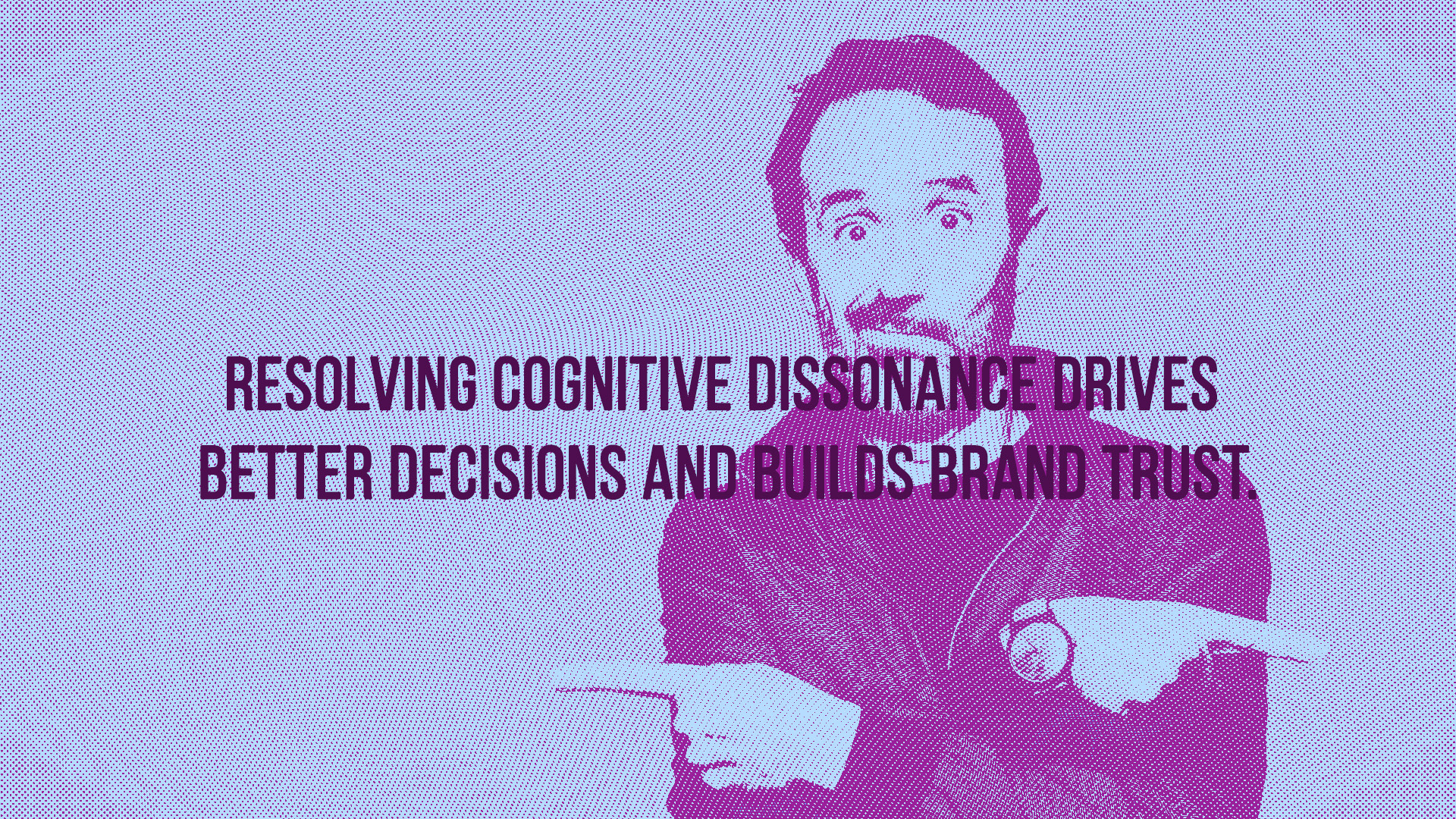Table of contents
Cognitive dissonance refers to the psychological discomfort individuals experience when holding two or more conflicting beliefs, values, or attitudes. This phenomenon, first introduced by psychologist Leon Festinger in 1957, explains why people strive to maintain consistency in their thoughts and behaviours. In essence, when faced with contradictions, individuals are motivated to resolve the dissonance, either by changing their beliefs or justifying their choices.
In marketing, cognitive dissonance plays a critical role as consumers often encounter conflicting information or emotions during their decision-making processes. For example, a person may desire a high-quality product but feel uneasy about its cost. This tension creates a unique opportunity for marketers to align their messaging to reduce discomfort and nudge consumers toward making decisions that favour their brand.
Relevance in consumer psychology and marketing
In consumer psychology, cognitive dissonance is a powerful driver of behaviour. People naturally seek harmony between their desires, actions, and self-image. When purchasing decisions create conflict—such as guilt over indulgence or doubts about quality—consumers may seek reassurance to resolve these feelings. Understanding this dynamic enables marketers to craft strategies that address these internal conflicts, making it easier for consumers to commit to their choices.
For businesses, leveraging cognitive dissonance effectively can lead to stronger customer relationships and increased loyalty. By reducing the discomfort tied to purchasing decisions—through reassurance, testimonials, or guarantees—brands can position themselves as trustworthy allies in their customers’ lives. This approach not only aids immediate sales but also fosters long-term engagement and advocacy.
Understanding cognitive dissonance
Cognitive dissonance, as introduced by Leon Festinger in 1957, describes the psychological tension that arises when individuals hold conflicting cognitions—such as beliefs, attitudes, or actions. Festinger’s pioneering research demonstrated that this discomfort motivates individuals to take corrective actions, either by altering their beliefs, acquiring new information, or minimising the importance of the conflict. This theory has since become a cornerstone of social psychology, with widespread applications in various fields, including marketing.
Historically, the concept was first observed in scenarios where individuals justified their choices despite apparent contradictions. Festinger’s early studies, such as the famed experiment involving participants paid varying amounts to lie about a boring task, highlighted the human tendency to reconcile conflicting emotions to restore cognitive harmony. These foundational insights remain relevant in understanding consumer decision-making today.
Key theories and psychological principles
Several key principles underlie cognitive dissonance, with the most prominent being the principle of consistency. People naturally desire coherence between their beliefs and actions, striving to avoid the discomfort of dissonance. When this balance is disrupted—such as when a consumer purchases an expensive item and later questions its value—they seek resolution, often through self-justification or seeking validating information.
Another significant principle is effort justification, which explains why people tend to value outcomes more highly if they have invested significant effort or resources into achieving them. In marketing, this principle is leveraged to enhance perceived value, such as through loyalty programmes or exclusive membership benefits.
The role of cognitive dissonance in decision-making
Cognitive dissonance significantly influences consumer purchasing decisions, often acting as a barrier to commitment or a motivator for justification. When consumers encounter products or services that challenge their existing beliefs, they experience discomfort, which can deter them from making a purchase.
To overcome this discomfort, consumers typically employ strategies such as seeking additional information, adjusting their expectations, or rationalising their choices. Marketers who recognise these patterns can craft messaging that reduces uncertainty. For example, highlighting the long-term value of a product can help ease concerns about upfront costs, making the decision process smoother and more reassuring.
Examples of conflicting beliefs and their impact
Common instances of conflicting beliefs arise when consumers’ desires clash with their perceived responsibilities or values. For example, someone might want to indulge in a luxury holiday but feel guilt over the expense, or they might consider buying a sustainable product but doubt its efficacy compared to conventional alternatives. These conflicts can result in decision paralysis or post-purchase regret.
Marketers can address these conflicts by aligning their brand narratives with consumer values. For example, showcasing testimonials, data-backed benefits, or ethical credentials can help resolve dissonance. A travel company, for instance, might focus on eco-friendly initiatives to reassure environmentally conscious travellers, effectively resolving their conflicting desires for luxury and sustainability.
Examples of cognitive dissonance in marketing
Brands that understand and utilise cognitive dissonance in their strategies often achieve notable success by resolving consumer conflicts. One famous example is Apple’s “Think Different” campaign. By appealing to consumers’ desire to stand out and challenge norms, Apple subtly created a dissonance in users of competing products who wanted to align with this innovative, nonconformist identity. This messaging encouraged many to switch to Apple products to resolve the discomfort of not belonging to the “Think Different” ethos.
Another example is the use of limited-time offers by retailers such as Amazon during events like Prime Day. Consumers who hesitate to purchase may feel a conflict between their desire for the product and their reluctance to spend.
Real-world examples of dissonance in advertising and branding
Advertising often plays a critical role in surfacing and addressing cognitive dissonance. For example, Coca-Cola’s “Share a Coke” campaign personalised bottles with names, fostering a sense of personal connection. For consumers who were loyal to other beverages, the campaign created dissonance by highlighting the joy and inclusivity associated with Coca-Cola, prompting many to make the switch to align with these positive emotions.
Similarly, Nike’s “Just Do It” campaign taps into motivational dissonance. It challenges individuals who feel unmotivated or disconnected from fitness goals by presenting a narrative of empowerment and determination. The implied message that “inaction conflicts with your potential” spurs consumers to purchase Nike products as a means of resolving this internal conflict and aligning with the aspirational identity promoted by the brand. These examples demonstrate how marketing strategies can effectively leverage cognitive dissonance to drive engagement and loyalty.
Strategies to identify cognitive dissonance in your audience
Identifying cognitive dissonance in your audience requires a keen understanding of their motivations, beliefs, and pain points. One effective approach is leveraging surveys and focus groups to uncover discrepancies between consumer expectations and their actual experiences. For instance, direct questions about what consumers value versus what they feel is lacking in a product or service can reveal areas of potential dissonance.
Additionally, social media listening tools provide valuable insights into consumer sentiment. Analysing online reviews, comments, and discussions can highlight instances where customers express regret, frustration, or conflicting emotions about their choices. Such feedback allows marketers to pinpoint specific issues and address them through targeted messaging or product improvements.
Identifying gaps between consumer expectations and experiences
A critical aspect of resolving cognitive dissonance is understanding where the gap lies between what consumers expect and what they perceive they receive. Identifying these gaps can be achieved by mapping customer journeys and collecting feedback at each touchpoint.
Another method involves analysing data from customer complaints and support interactions. Patterns in negative feedback can signal inconsistencies in brand messaging or product delivery. For instance, if a fitness app promises ease of use but generates frequent complaints about complexity, this gap can create dissonance. Addressing these discrepancies through enhanced communication or product adjustments not only resolves the conflict but strengthens consumer trust and satisfaction.
Tactics for aligning messaging with consumer values

Aligning brand messaging with consumer values is a powerful strategy for leveraging cognitive dissonance. Brands can create campaigns that resonate deeply by highlighting shared principles or addressing consumer pain points. For instance, a company focusing on sustainability can reduce dissonance for eco-conscious consumers by emphasising its environmental efforts, such as using recycled materials or carbon-neutral production processes.
Another effective tactic is personalised marketing. For example, recommending products based on past purchases or preferences reassures consumers that their choices align with their values, minimising the likelihood of second-guessing their decisions.
The power of storytelling in resolving conflicts
Storytelling is an essential tool in resolving consumer dissonance, as it creates an emotional connection and provides context that justifies a decision. A compelling narrative can transform a purchase from a mere transaction into a meaningful action. For example, TOMS Shoes effectively uses storytelling by showcasing how every purchase supports a good cause, such as donating shoes to those in need. This narrative helps consumers resolve any guilt about spending by framing the purchase as a socially responsible choice.
Similarly, testimonial-driven campaigns can reduce dissonance by offering relatable stories from satisfied customers. Hearing how others overcame similar conflicts—such as concerns about price versus quality—can reassure potential buyers. These stories act as validations, helping consumers feel more confident in aligning their decisions with the brand’s promises and their own expectations. Through storytelling, marketers can bridge gaps in belief and behaviour, fostering trust and loyalty.
Summary of key insights
Cognitive dissonance is a fundamental concept in consumer psychology that significantly impacts purchasing behaviours. When consumers face conflicting beliefs or emotions, they experience discomfort, which can deter them from making a decision or lead to post-purchase regret. Understanding this phenomenon allows marketers to craft strategies that address and resolve these conflicts effectively. From creating campaigns that align with consumer values to employing storytelling to build emotional connections, addressing cognitive dissonance helps brands guide their audience toward confident decisions.
Tools like surveys, social media listening, and customer feedback provide invaluable insights into audience sentiments. Aligning messaging with consumer values and employing personalised approaches can preempt potential conflicts, fostering trust and loyalty.
Future implications of cognitive dissonance in marketing
As consumer awareness and expectations continue to evolve, cognitive dissonance will remain a critical factor in shaping marketing strategies. Modern consumers are more informed and discerning, making it crucial for brands to maintain consistency between their promises and actual offerings. The rise of digital platforms also means that feedback—both positive and negative—spreads quickly, magnifying the impact of unresolved dissonance.
Marketers must stay proactive by continuously analysing consumer behaviours and adapting their approaches to address new sources of conflict. Transparency and authenticity will play an increasingly vital role in resolving dissonance while preserving brand integrity.
FAQs
What are the common signs of cognitive dissonance in consumers?
Cognitive dissonance often manifests as hesitation, regret, or uncertainty during or after a purchase. Common signs include prolonged decision-making, frequent requests for reassurance, or seeking validation through reviews and recommendations. Post-purchase behaviours, such as returning items or leaving critical reviews, can also indicate unresolved dissonance.
How can small businesses leverage cognitive dissonance effectively?
Small businesses can utilise cognitive dissonance by focusing on personalised and transparent marketing. Highlighting value propositions that directly address customer pain points—such as affordability, quality, or ethical practices—can resolve conflicts. Offering guarantees, such as money-back policies or testimonials, can also provide reassurance and reduce hesitation among potential buyers.
What tools help track and manage consumer dissonance?
Surveys, customer feedback forms, and online review platforms are key tools for tracking cognitive dissonance. Social media listening tools like Brandwatch or Hootsuite Insights can monitor consumer sentiment, while customer journey mapping helps identify touchpoints where dissonance might arise. Analysing customer support interactions can also reveal recurring conflicts.
How does cognitive dissonance relate to brand loyalty?
Addressing cognitive dissonance effectively can strengthen brand loyalty. When consumers feel their concerns are understood and resolved, they are more likely to trust the brand. Consistent messaging, aligning with consumer values, and transparent practices help create positive associations, fostering repeat purchases and advocacy.
Can resolving dissonance backfire if not executed correctly?
Yes, poorly executed attempts to resolve cognitive dissonance can backfire, leading to mistrust or dissatisfaction. For instance, overpromising in marketing messages without delivering can amplify dissonance. It’s essential for brands to maintain authenticity and provide clear, consistent information to avoid further complications. Addressing conflicts transparently ensures a more positive outcome.







